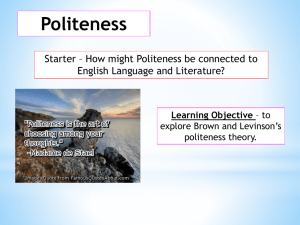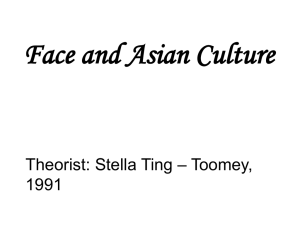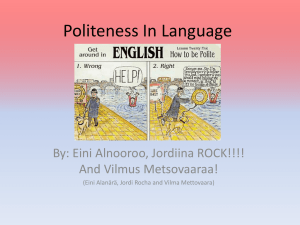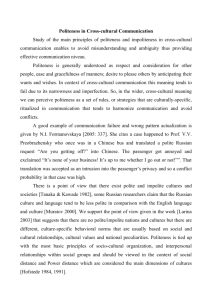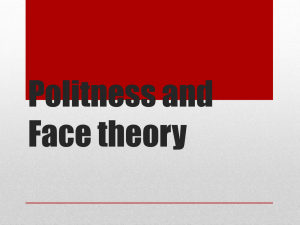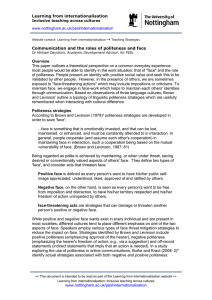Politeness
advertisement
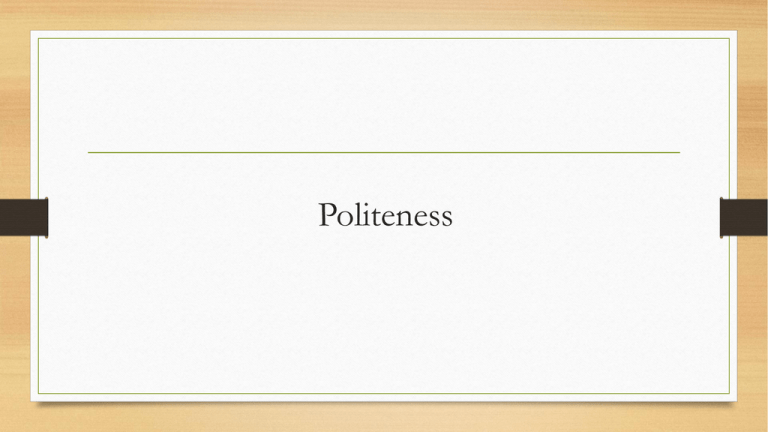
Politeness What is Politeness • In societies where interactions between strangers, it seems very rude to ignore the distance there might be between you and your addressee and to talk as if you know her or him better than you do. • Politeness is the actions taken by competent speakers in a community in order to attend to possible social or interpersonal disturbance. Politeness in Cultures • This greater orientation to in some cultures means that use of first names is the norm, even in professional contexts in much of the English-speaking world (though this seems to still be true more in North American and Australasian universities than in UK universities). This tendency interacts with other social factors, such as the addressee age and sex. For example, younger university professors are more likely to be addressed by their first name than their older colleagues are. Moreover, many women report an asymmetry between the way that they are addressed (e.g., First Name or Mrs. + Surname・ and their male peers (e.g., Title + Surname) • All languages have devices to indicate politeness and formality. • Linguistic markers of status, deference, humility • Posture, facial expressions, gestures, etc. • Politeness is closely tied to cultural values. One must know the cultural values in order to function successfully in a society. Face • The sociologist Erving Goffman, who used the term to discuss some of the constraints on social interaction. In Goffman’s work, ‘face’ was a personal attribute or quality that each of us works to protect or enhance. • Face and face wants: Erving Goffman’s notion of face, our social persona, adopted into politeness theory. Face wants are the desire to protect our positive face and negative face from threat or damage. Face • As in: to lose face, to save face. • Your face is your ‘public self-image’ (Brown and Levinson). • It’s the rights you claim from others: • The positive right to be respected: respect. • The negative right to be unimpeded: freedom. • The kind of respect and freedom you claim depends on your selfclassification. Types of Face • Brown and Levinson propose that we want to guard our face against possible damage when we interact with others. So, they distinguish between • Negative face is the want of every competent adult member of a community that their actions be unimpeded by others.(Not to be imposed upon) • Positive face is the want of every member that their wants be desirable to at least some others. (To be liked) Brown and Levinson’s Politeness Theory • Brown and Levinson suggested that it was useful to distinguish two types of politeness. • They called the strategies that avoid offence by showing deference (respect and esteem due a superior or an elder ) negative politeness strategies • 2- the strategies that avoid offence by highlighting friendliness positive politeness strategies. • They also suggest that whether we consider a strategy polite or impolite depends on how much attention or what kind of attention a speaker pays to their own and their addressee’s face wants. Compare • ‘Ahmad! I haven’t seen you in years. You look terrific! What are you up to?’ • ‘Excuse me, Dr Michaels, I’m sorry but could I just interrupt you for one moment?’ Politeness Strategies • Negative politeness strategies An action, phrase or utterance that indicates attention is being paid to the negative face wants of an interlocutor. Often achieved through shows of deference. One type of action available to mitigate an inherently face-threatening act. • Positive politeness strategies An action, phrase or utterance that indicates attention is being paid to the positive face wants of an interlocutor. Often achieved through shows of friendliness. One type of action available to mitigate an inherently face-threatening act. Choosing politeness strategies: power, distance and cost of the imposition • Our decisions about exactly what kinds of strategies would be polite or impolite in a given situation involve an evaluation of a number of different factors. Brown and Levinson identify three specific factors. We consider how great a power difference there is between the speaker and the addressee; we consider how great the social distance is between the speaker and the addressee; and we evaluate the cost of the imposition. Face Threatening Acts (FTAs) • Speech Acts: Utterances which, in saying, do something. • Brown and Levinson suggest that some conversational events are inherently face threatening acts. That is, once you undertake one of these acts, it is impossible not to have somebody’s positive or negative face wants threatened (sometimes it will be the speaker’s, sometimes it will be the hearer’s). FTAs • • • • • What’s the time? (request) Pass the salt. (order) You’ve got toothpaste on your shirt. (criticism or bad news about H) It’s not ready yet. (warning) Sorry. (make apology) FTAs redressed • Could you tell me the time? (request: does not assume compliance) • There’s something on your shirt. (bad news about H: minimise; depersonalise) • Gentlemen, you can’t park there. (warning: show deference) • I’m sorry to interrupt . . . (interrupting: apologise)
